Introduction
Analyzing various social and economic indicators of a community in a given population is vital. The analysis provides necessary information that can be used to describe the population in turns of the population distribution, income, marital status,age, employment, housing and medical insurance coverage. Besides, such analysis provides the state with adequate information that can be useful for economic planning. Therefore, the treatise seeks to carry out an analysis of the population of foreign-born Chinese in the United States. Specifically, the paper will analyze the various social, economic and demographic variables of foreign-born Chinese in the United States. The descriptive analysis will be based on secondary data collected from various sources on the internet. However, much of the data will be collected from the website of American Community Survey and United States Census Bureau web sites (United States Census Bureau 1). The analysis will entail presenting graphical depiction of the data collected and a brief description of the data.
Population of the foreign-born Chinese in the United States
The proportion of the total foreign-born residents in the United States is 14.95%. The percentage gives the total number of immigrants into the United States in relation to the total population of the United States. The Chinese residents’ accounts for only 0.73% of the entire population of the United States. Further, foreign-born Chinese in the United States accounts for 3.55% of the foreign-born residents in the United States. Further, out of the entire population of Chinese in the United States (2,292,233), 63.20% are foreign-born while 36.80% are native-born. Thus, it can be observed that the proportion of the foreign-born Chinese in the United States is higher than the proportion of the native-born residents. The distribution of the foreign-born and the native-born Chinese residents in the United States will have an impact on other variables in the economy.
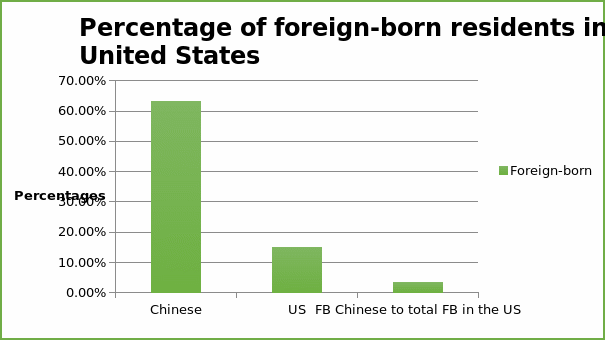
Based on the graph presented above, it can be observed that the proportion of foreign-born Chinese residents in relation to their total population in the United States is higher than the proportion of the foreign-born residents in the United States. Further, it can be observed that the proportion of the foreign-born Chinese to the total foreign-born residents in the United States is quite low. The foreign-born Chinese residents can also be analyzed based on the percentage of the population that immigrated into the United States over time (United States Census Bureau 1). This will be achieved by analyzing the proportion of the population foreign-born who immigrated into the United States over the years. Figure 1.1 shows the percentage of foreign-born and foreign-born Chinese who entered the United States across various time periods.
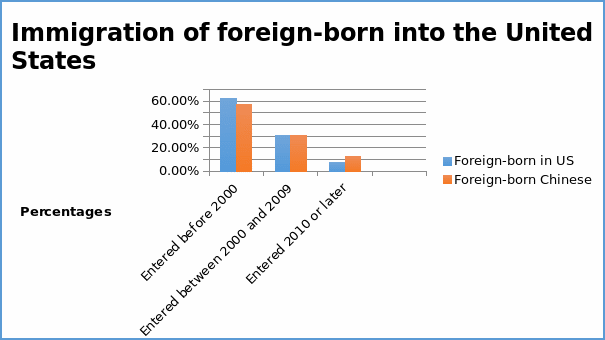
The graph indicates that foreign-born residents began to enter the United States way before 2000. The statistics indicate that 62.70%of the foreign-born residents entered the United Stated before the year 2000. The large proportion of immigrants can be attributed to the favorable immigration laws that opened borders for the foreign-born from various origins across the world. Further, between 2000 and 2009, 30.40% of the foreign-born residents entered the United States while after the year 2010 only 7.00% of the foreign-born residents entered the United States (Gibson and Jung 28). The declining trend can be attributed to the stiffened immigration laws due to security concerns in the country.
The percentage of the foreign-born Chinese residents who entered the country also followed the same trend. 57.60% of the foreign-born Chinese residents entered the United Stated before the year 2000, 30.20% of the foreign-born Chinese residents entered the United States between 2000 and 2009 and 12.3% of the foreign-born Chinese residents entered the United States after 2010. The Chinese population in the United States can also be analyzed based on the distribution of the citizens and non-citizens. The data show that 56.92% of the Chinese residents in the United States are citizens while 43.08% of the residents are non-citizens. On the other hand, 5.95% of the foreign-born residents in the United States are citizens while the remaining 94.05% of the foreign-born residents in the United States are non-citizens. Thus, it can be concluded that a large proportion of the foreign-born Chinese in the United States are citizens when compared to the proportion of the foreign-born residents in the United States who are citizens (United States Census Bureau 1).

Age distribution and marital status
Analysis of age and marital status of a given population or sub-population is important because it gives data that can be used for various analysis and planning. Based on the data collected, foreign-born Chinese in the United States is made up of 44.6% male and 56.0% female. Therefore, it can be observed that female Chinese residents are the majority. The same trend can be observed when analyzing the proportion of the male and female for the total population of foreign-born in the United States. The foreign-born residents in the United States are made up of 48.70% male and 51.30% female. Thus, the total population of the foreign-born female residents in the United States is higher than the male residents (United States Census Bureau 1). This distribution will affect other variables such as marriage among others.
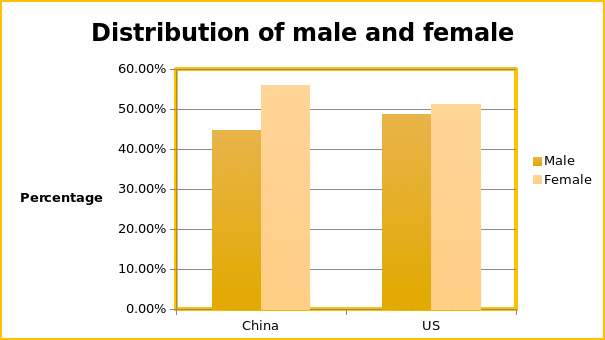
Apart from the distribution of male and female, the population of foreign-born Chinese in the United States can be analyzed based on the age distribution. Based on the statistics of the population, it can be observed that residents of foreign-born Chinese in the United States have a slightly higher percentage of older people than younger people. This can be justified by the fact that the age distribution indicates that 0.6% of the foreign-born Chinese in the United States are children below five years, 5.9% of the population lies between 5 to 17 years, 10.1% of the population lies between 18 to 24 years, 15.2% of the population lies between 25 to 34 years, 18.1% of the population lies between 35 to 44 years, 19.4% of the population lies between 45 to 54 years, 15.4% of the population lies between 55 to 64 years, 8.3% of the population lies between 65 to 74 years, while 6.9% of the population age 75 year and above.
Thus, it can be observed that the highest percentage of the population falls in the age group 45 to 54 years old. Further, the age distribution also indicates that 68.1% of the foreign-born Chinese in the Unites States are 35 years old and above. Only 30.7% of the population falls under 35 years. A similar trend can be observed in the case of foreign-born residents in the United States. The data collected shows that 0.6% of the foreign-born in the United States are children below five years, 5.7% of the population lies between 5 to 17 years, 7.9% of the population lies between 18 to 24 years, 19.0% of the population lies between 25 to 34 years, 21.9% of the population lies between 35 to 44 years, 18.4% of the population lies between 45 to 54 years, 13.0% of the population lies between 55 to 64 years, 7.7% of the population lies between 65 to 74 years, while 5.7% of the population age 75 year and above.
Thus, it can be observed that the highest percentage of the population falls in the age group 35 to 44 years old. Further, the age distribution also indicates that 66.8% of the foreign-born Chinese in the Unites States are 35 years old and above. Only 33.7% of the population falls under 35 years. (United States Census Bureau 1). The distribution of the population can also be attributed to the immigration laws put in place by the government of the United States. Figure 1.4 shows the distribution of age.
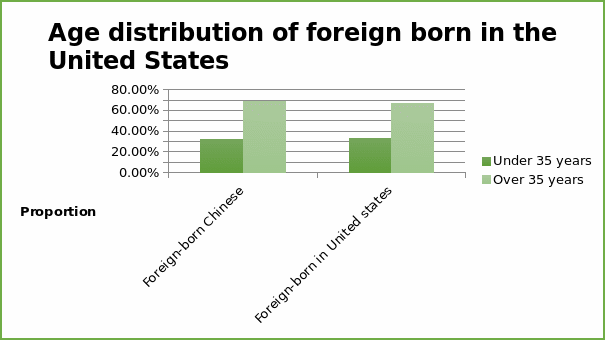
Apart from age distribution the foreign-born Chinese in the United States can also be analyzed based on the median age. Based on the data collected, the foreign-born Chinese have a median age of 45 years. The value of relatively higher than the median age for the native-born Chinese (27 years). Further, the median age of the Chinese citizens is 29 years while the median age of the non-citizen Chinese is 41 years. The median age of the foreign-born Chinese can be compared to the median age of the foreign-born residents in the United States. The data show that the foreign-born residents have a median age of 42.6 years while the native born have a median age of 35.8 years. Further, the median age of the foreign-born citizens is 38.6 years while the median age of the non-citizen Chinese is 36 years (United States Census Bureau 1). On average, it can be noted that the foreign-born resident have a higher median age than the foreign-born Chinese in the United Stated.
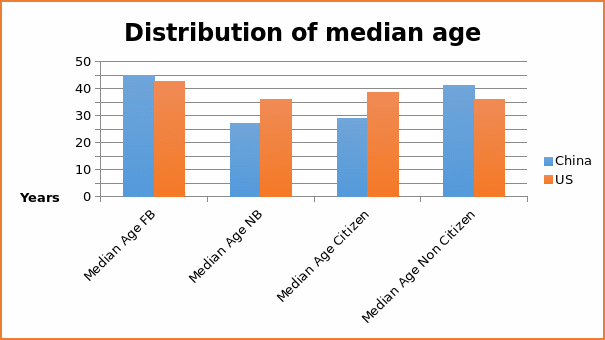
A foreign-born population where a large proportion of are aged above 35 years is suitable for the economy because they will be economically productive. The population will provide human capital for the economy and this is essential for growth and development. Besides, a large percentage of immigrants that are aged above 35 years will contribute positively to the economy will because they will contribute to transfer of knowledge in the economy. This knowledge transfer is important for growth of technology and human capital in the US economy. Besides, the population will require little amount of investment in terms of education and training. Thus, the laws which regulate the age and the educational attainment of the foreign born immigrant is suitable for economic growth and development of the country.
The foreign-born Chinese in the United states can also be reviewed based on the marital status. The data collected reveals that 64.30% of the foreign-born Chinese are married while 58.60% of the foreign-born residents in the United States are married. Thus, a high proportion of the foreign-born Chinese are married as compared to the foreign-born residents in the United States. The data also reveal that 38.75% of the native-born Chinese, 51.53% of the Chinese citizens and 65.43% of the Chinese who are non-citizens are married. In the section above, it was indicated that 56.92% of the Chinese residents in the United States are citizens while 43.08% of the residents are non-citizens. However, it can be observed that a higher percentage of the Chinese citizens are married as compared to the Chinese who are non-citizens. The high percentage of the foreign-born Chinese who are married can be explained by the high percentage of older people in the population.
The marriage statistics can also be analyzed based on the proportion of male and female who are married. The data indicate that 67.1% of the foreign-born Chinese male in the United States who aged above 15 years are married while 62.0% of the foreign-born Chinese female in the same age bracket are married. In the case of foreign-born resident in the United States, 56.6% of the foreign-born male in the United States who aged above 15 years are married while 50.6% of the foreign-born female in the same age bracket are married. Thus, there is a large proportion of the male resident is married as compared to the female residents. Besides, the proportion of male and female foreign-born Chinese who are married is higher than the proportion of the male and female foreign-born residents in the United States.
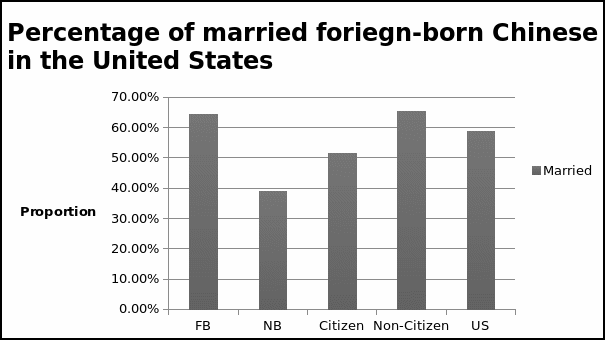
Education
Analyzing educational attainment and enrollment is of necessary because it shows the contribution of the population to the growth and development of an economy. The educational attainment will be classified into four groups. The groups will reveal the percentage of the population that has attained the educational level in that group. The data collected shows that 20.8% of the foreign-born Chinese have attained less than a high school diploma, 15.8% have attained a high school graduate and its equivalents, 13.8% have some college education or associated degree while 49.6% of the population have attained a bachelor’s degree and above.
The statistics can be compared to the foreign-born residents in the United States; 30.8% of the foreign-born residents have attained less than a high school diploma, 22.2% have attained a high school graduate and its equivalents, 19.1% have some college education or associated degree while only 28% of the population have attained a bachelor’s degree and above. Thus, it can be noted that 79.2% of the foreign-born Chinese residents are high school graduates and above while only 69.2% of the foreign-born residents are high school graduates and above. Thus, foreign-born Chinese residents have a relatively higher educational attainment than the foreign-born residents in the United States (United States Census Bureau 1).

The high educational attainment contributed significantly to the economic growth and development in the United States. Enrollment to various categories of learning also plays an important role in educational attainment and economic growth. The data collected show that 1.6% of the foreign-born residents are enrolled in nursery school, 1.5% of the population is enrolled in the kindergarten, 16.1% are enrolled in elementary school, 12.0% are enrolled in high school and 68.8% of the population is enrolled in 61.8%.
The statistics can be compared to the case of foreign-born residents in the United States; 1.4% of the foreign-born residents are enrolled in nursery school, 1.6% is enrolled in the kindergarten, 22.2% is enrolled in elementary school, 20.9% is enrolled in high school and 68.8% of the population is enrolled in 53.9%. The distribution shows that a higher percentage of foreign-born Chinese have enrolled in colleges and higher learning institution than the foreign-born residents in the United States. This data on enrollment can also explain the high proportion of foreign-born Chinese residents who have attained college education and above (United States Census Bureau 1).
Labor force participation
The data indicates that 61.90% of the foreign-born Chinese participate in the labor force within the US. The value is slightly lower than the percentage of the foreign-born residents who participates in the labor force (66.90%). This can be an indication that there is a higher chance other foreign-born from various origins will participate in the labor force within the United States than the foreign-born Chinese. Further, the statistics show that 35.60% of the native-born Chinese participates in the labor force within the US. This can be an indication that the foreign-born citizens have a higher chance of participating in the labor force than the native born citizen. Further, 47.60% of the Chinese citizens participate in the labor force while 54.70% of Chinese who are non-citizens participates in the labor force. This indicates that the non-citizens have a higher chance of participating in the labor force than the Chinese citizens.

In terms of employment, only 3.90% of the foreign-born Chinese residents are unemployed. The value is slightly higher than the percentage of foreign-born residents who are unemployed (5.70%). The low percentage can be attributed to the high level of education discussed above. Further, 5.60% of the native-born Chinese are unemployed, 6.99% of the Chinese citizens are unemployed and 8.07% of the Chinese who are non-citizens are unemployed.

Medical insurance
The statistics show that 17.70% of the foreign-born Chinese residents do not have medical insurance cover while 32.80% of the entire population of the foreign-born in the United States does not have medical cover.
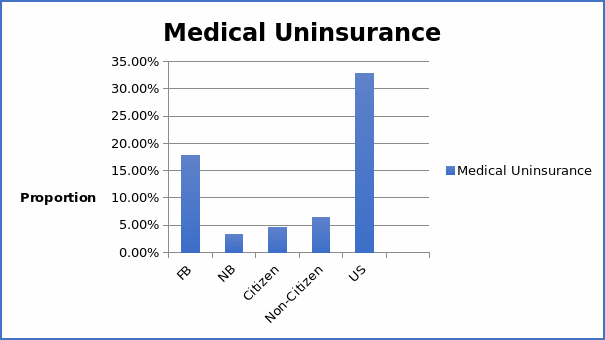
Earnings
Analyzing earnings of the foreign-born Chinese residents in the United States gives an indication of the economic well-being of the group. The individual per-capita income of a foreign-born Chinese is $35,930. The value is higher than the individual per capita income of a foreign-born resident in the United States ($29,119). Further, the median household income in the past 12 months was $59,874 for foreign-born Chinese and $46,983 for foreign-born in the United States. Also, the median family income was $73,052 for foreign-born Chinese and $50,844 for foreign-born in the United States. Further, earnings can also be analyzed for male and female full time, year round workers.
The data show that the population of male foreign-born Chinese was 471,293 with a median income of $76,575 while the female were 415,980 with a median income of $62,178. In the case of foreign-born residents in the United States, the male foreign-born Chinese were 10,353,300 with a median income of $55,746 while the total number of female workers was 6,454,033 with a median income of $44,622. On average, there is a large number of male Chinese workers in the United States than female workers. Besides, the male earns a higher income than the female. Further, the poverty level for all families of foreign-born Chinese residents was 12.0% while the level for foreign-born residents is 18.4%. Therefore, the Chinese in the United States have a lower poverty level than the foreign-born residents in the country.
Works Cited
Gibson, Campbell, and K. Jung. Foreign-born Population of the United States, 1850 to 2000, United States: Nova Publishers, 2005. Print.
United States Census Bureau 2013, American Community Survey. Web.